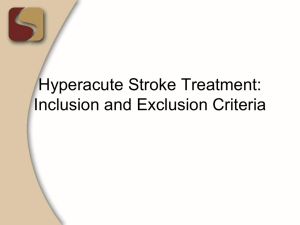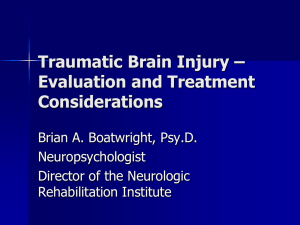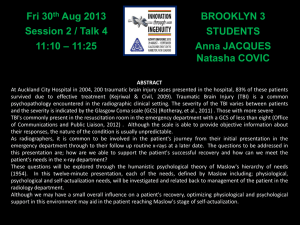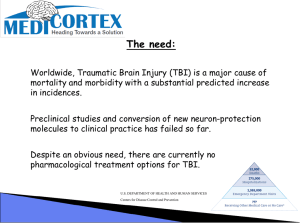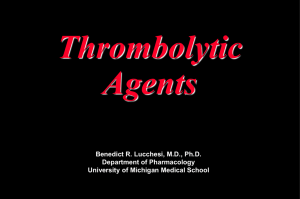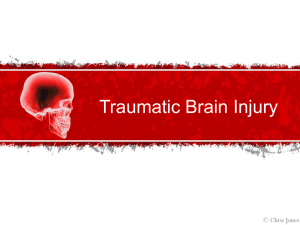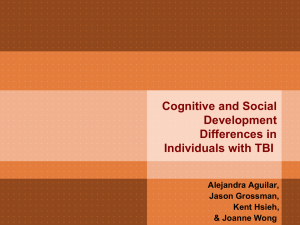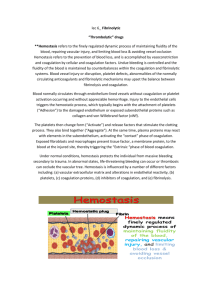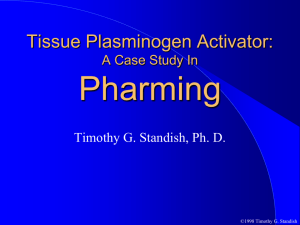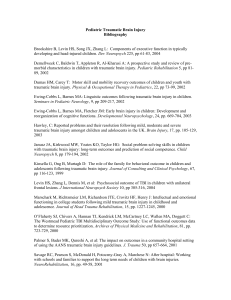Role of Tissue Type Plasminogen Activator in TBI
advertisement
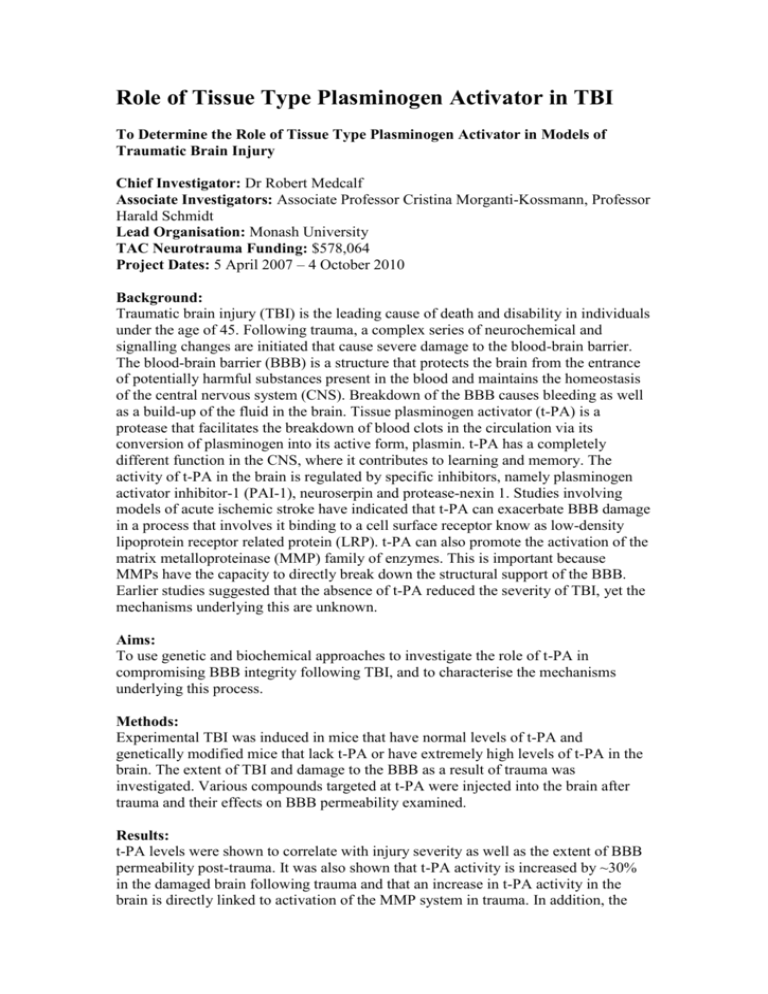
Role of Tissue Type Plasminogen Activator in TBI To Determine the Role of Tissue Type Plasminogen Activator in Models of Traumatic Brain Injury Chief Investigator: Dr Robert Medcalf Associate Investigators: Associate Professor Cristina Morganti-Kossmann, Professor Harald Schmidt Lead Organisation: Monash University TAC Neurotrauma Funding: $578,064 Project Dates: 5 April 2007 – 4 October 2010 Background: Traumatic brain injury (TBI) is the leading cause of death and disability in individuals under the age of 45. Following trauma, a complex series of neurochemical and signalling changes are initiated that cause severe damage to the blood-brain barrier. The blood-brain barrier (BBB) is a structure that protects the brain from the entrance of potentially harmful substances present in the blood and maintains the homeostasis of the central nervous system (CNS). Breakdown of the BBB causes bleeding as well as a build-up of the fluid in the brain. Tissue plasminogen activator (t-PA) is a protease that facilitates the breakdown of blood clots in the circulation via its conversion of plasminogen into its active form, plasmin. t-PA has a completely different function in the CNS, where it contributes to learning and memory. The activity of t-PA in the brain is regulated by specific inhibitors, namely plasminogen activator inhibitor-1 (PAI-1), neuroserpin and protease-nexin 1. Studies involving models of acute ischemic stroke have indicated that t-PA can exacerbate BBB damage in a process that involves it binding to a cell surface receptor know as low-density lipoprotein receptor related protein (LRP). t-PA can also promote the activation of the matrix metalloproteinase (MMP) family of enzymes. This is important because MMPs have the capacity to directly break down the structural support of the BBB. Earlier studies suggested that the absence of t-PA reduced the severity of TBI, yet the mechanisms underlying this are unknown. Aims: To use genetic and biochemical approaches to investigate the role of t-PA in compromising BBB integrity following TBI, and to characterise the mechanisms underlying this process. Methods: Experimental TBI was induced in mice that have normal levels of t-PA and genetically modified mice that lack t-PA or have extremely high levels of t-PA in the brain. The extent of TBI and damage to the BBB as a result of trauma was investigated. Various compounds targeted at t-PA were injected into the brain after trauma and their effects on BBB permeability examined. Results: t-PA levels were shown to correlate with injury severity as well as the extent of BBB permeability post-trauma. It was also shown that t-PA activity is increased by ~30% in the damaged brain following trauma and that an increase in t-PA activity in the brain is directly linked to activation of the MMP system in trauma. In addition, the deleterious effects of t-PA at promoting TBI severity occurs via its association with its inhibitors, notably PAI-1, which in turn triggers deleterious signalling processes leading to BBB damage. Conclusions: These results suggest that t-PA promotes TBI severity increasing BBB permeability via the formation of t-PA-inhibitor complexes and signalling via LDL receptors that may in turn lead to an increase in MMP recruitment. Inhibition of t-PAcomplex formation or subsequent downstream signalling via LDL receptors would offer a new approach to minimise the severity of TBI. Publications: SASHINDRANATH M, SAMSON AL, DOWNES CE, CRACK PJ, LAWRENCE AJ, LI Q-X, PING NG AQ, JONES NC, FARRUGIA J, ABDELLA E, VASSALLI J-D, MADANI R, MEDCALF RL. Compartment- and context-specific changes in tissue-type plasminogen activator (tPA) activity following brain injury and pharmacological stimulation. Laboratory Investigation. 2011;91:1079-1091. Presentations: MEDCALF R. Role of tissue type plasminogen activator in TBI. Trauma Melbourne; 2009 November 20-21, Melbourne, Australia. SASHINDRANATH M, KARADIMOS D, BECKHAM S, GALLE A, FARRUGIA J, MADANI R, VASSALLI JD, MEDCALF RL. Increased permeability of the blood-brain barrier and more severe motor impairment following traumatic brain injury in mice over-expressing tissue type plasminogen activator (t-PA). The Second Joint Symposium of the International and National Neurotrauma Societies; 2009 September 7-11, Santa Barbara, USA. SASHINDRANATH M, KARADIMOS D, BECKHAM S, GALLE A, FARRUGIA J, MADANI R, VASSALLI JD, MEDCALF RL. Neuronal Over-expression of t-PA accelerates MMP-9 activation following traumatic brain injury. XIIth International Workshop on Molecular & Cellular Biology of Plasminogen Activation; 2009 March 31-April 4, Cold Spring Harbour, USA. SASHINDRANATH M, KARADIMOS D, BECKHAM S, GALLE A, MEDCALF RL. Neuronal Over-expression of Tissue-type Plasminogen Activator correlates with Increased Matrix Metalloproteinase-9 Activation following Traumatic Brain Injury. 29th Annual Meeting of the Australian Neuroscience Society; 2009 January 27-30, Canberra, Australia. SASHINDRANATH M, SALES E, FARRUGIA J, KARADIMOS D, BECKHAM S, GALLE A, MADANI R, VASSALLI J-D, MEDCALF R. Increased permeability of the blood-brain barrier and more severe motor impairment following traumatic brain injury in mice over-expressing tissue type plasminogen activator (t-PA). National and International Neurotrauma Societies; 2009 September 7-11, Santa Barbara, USA. SASHINDRANATH M, KARADIMOS D, MEDCALF RL. Increased endogenous tissue typeplasminogen activator (T-PA) correlates with increased matrix metalloproteinase-9 activation following traumatic brain injury. 29th Annual Meeting of the Australian Neuroscience Society; 2009 January 27-30, Canberra, Australia. SASHINDRANATH M, SALES E AND MEDCALF RL. Tissue-type plasminogen activation, the blood brain barrier and traumatic brain injury. 20th International Congress on Fibrinolysis and Proteolysis; 2010 August 24-28, Amsterdam, Netherlands. SAMSON AL, BORG RJ, SASHINDRANATH M, AU AE-L, NIEGO B, CODY S AND MEDCALF RL. Identification of proteins that selectively misfold within the acutely injured brain and accelerate tPA-mediated plasmin formation: implications for ischemic stroke. 20th International Congress on Fibrinolysis and Proteolysis; 2010 August 24-28, Amsterdam, Netherlands. SASHINDRANATH M, SAMSON AL, ABDELLA E, LAWRENCE AJ, TARLAC V, DOWNES CE, CRACK PJ, AND MEDCALF RL. Quantitation of net tissue-type plasminogen activator activity following CNS stimulation and injury using a rapid and reliable amidolytic assay. 20th International Congress on Fibrinolysis and Proteolysis; 2010 August 24-28, Amsterdam, Netherlands. MEDCALF RL. t-PA, the blood brain barrier and Traumatic brain injury. Gordon Research Conference; 2010 February 14-19, Ventura, California, USA. SASHINDRANATH M, KARADIMOS D, BECKHAM S, GALLE A, FARRUGIA J, MADANI R, VASSALLI JD, MEDCALF RL. t-PA, the Blood Brain Barrier and Traumatic Brain Injury. Gordon Research Conference; 2010 February 14-19, Ventura, California, USA. Other Grants: NHMRC Project Grant ID: 606660 Chief investigators: A/Prof Robert Medcalf To understand the role of the plasminogen activating and matrix metalloproteinase systems in traumatic brain injury ($481,500) NHMRC equipment grant fund ($28,000) to contribute towards the cost of a state of the art device to determine changes in motor function in mice and rats following TBI and in other neurological conditions. This device is called the Mouse DigiGait system.
